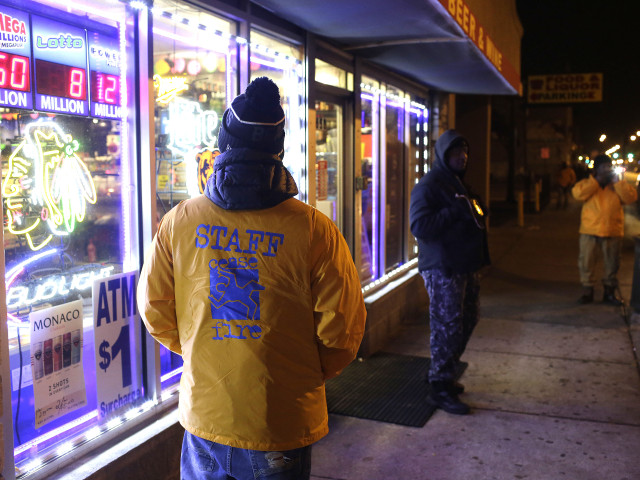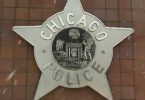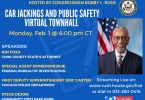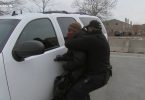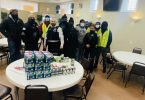Francisco Sanchez had been home from work only a few minutes when his cell phone rang a little after 3 a.m. with a call telling him: You need to head back out. Three people just got shot on your block.
As one of the small remaining corps of “violence interrupters” in Chicago, Sanchez’s job with the group CeaseFire Illinois is to use his connections on the Southwest Side of Chicago and his credibility as a onetime gang leader to prevent shootings. That means finding out who got shot and trying to make sure their friends don’t retaliate.
But tonight he needed help. There were people outside the police tape he didn’t know well. So he called a former colleague — a younger man who grew up on this block and knew the bystanders Sanchez thought seemed most likely to want to strike back.
Weeks earlier, though, the other man had been laid off when state funding cuts prompted CeaseFire and its parent organization Cure Violence to shut down 13 of the 14 Chicago sites where the violence interrupters worked. Now, he was in the middle of a shift at his new job, driving a tow truck.
Sanchez was understanding. “You know, he’s got to feed his family,” he said.
Created by Dr. Gary Slutkin, an epidemiology professor at the University of Illinois College of Medicine, Cure Violence has shown promise at helping prevent violent crime in Chicago. But since its inception in West Garfield Park in 2000, it’s struggled for funding. Most of that has come from government grants.
Just two years ago, its state funding was $4.5 million — the bulk of its budget. Then, in 2015, Gov. Bruce Rauner suspended its funding as part of his larger budget cuts amid the state’s financial crisis, despite Slutkin’s warning that “lives depend on this program.”
The city had given CeaseFire a $1 million grant in 2012 to hire 20 workers each on the South Side and on the West Side. But Mayor Rahm Emanuel pulled the plug the following year. Police officials were never fully supportive of the program, suspecting some CeaseFire workers were still involved in crime.
The same year, CeaseFire Illinois’ charismatic director, Tio Hardiman, was dismissed after being charged with beating his wife — a charge that was later dropped but still created a public relations problem for the group.
The Chicago chapter now exists on a few small grants from private donors, its few remaining foot soldiers struggling to make a difference in neighborhoods gripped by fear as the number of killings in the city surged last year to a level not seen in two decades.
But amid the bloodshed, CeaseFire’s financial struggles have brought staffing cuts from as many as 55 workers in 2014 to just eight today, leaving large swaths of the city uncovered.
“It hurts when we’re down,” says Joewaine Washington, a supervisor for the program in Englewood. “When there’s some static behind the scenes, there’s no one to call to talk about it.”
In Chicago, where gang territories are small, a violence interrupter who’s respected on one side of 69th Street in Englewood, say, might be unfamiliar to people on the other side — or, worse, mistrusted. The group says it needs at least one worker with strong connections in each of the warring gang districts.
One Saturday last month, a band of Cure Violence workers — some paid, some volunteers — met in a sparsely furnished storefront in Englewood. They were four men who, decades ago, were leaders in different South Side gangs. Around 9 p.m., they set off down 79th Street in orange windbreakers emblazoned “CeaseFire.”
People are pleased when they see them — in front of a liquor store where someone got shot the night before, walking past a gas station where a gang has been meeting.
When they stop by a club, the DJ stops the music and announces, “Interrupters in the hooouusseee!”

Customers at the Dana Dane Show Barber and Beauty Shop talk with CeaseFire supervisor Jowwaine Washington (orange jacket) as barber Dana Dane cuts another customer’s hair. | Joshua Lott / The Trace
At the Dana Dane Show Barber and Beauty Shop, they’re greeted with hugs and handshakes.
“People out here are hurting,” says shop owner Dana Kemp, whose brother was shot to death. “I can’t remember the last time they solved a murder out here. But CeaseFire keeps us safe in their own way. If anything’s going on, they be up on it.”
Last year, Englewood accounted for 9 percent of the city’s killings. Two years ago, CeaseFire employed about 30 outreach workers covering six police beats in Englewood. Four paid workers remain.
LeVon Stone Sr., program director for CeaseFire Illinois, says the fact that many of the violence interrupts are former criminals makes them credible to people doing the shooting.
“They really can’t give you no excuses because you did it yourself,” says Stone, who began work as an outreach worker in the same hospital where he was treated after being shot and paralyzed. “You can say, ‘Hey, I wasn’t the sharpest crayon in the box either, but I went back to school. I had a felony record, too, but I found a job.’ ”
The four remaining paid violence interrupters in Englewood recently negotiated a truce between two groups. One CeaseFire worker who’d been laid off knew the players well. He stepped in to negotiate a deal.
“There had been a body on both sides,” Washington says — one person from each gang killed. “We got them to agree to stay out of each other’s way.”
Later, though, men from the opposing gangs ran into each other on the street and traded insults. Washington and the other interrupters called the former colleague who had negotiated the truce. But he was out of town.
“Before he could get back, four people had been shot,” Washington says, two who died.
Leaders of Cure Violence — which now operates in 25 cities and six countries —say there’s a correlation between the funding cuts and Chicago’s skyrocketing violence, a claim experts say is impossible to prove, though the number of killings began to rise in April 2015, a month after CeaseFire’s state funding was cut.
A 2009 study by Wesley Skogan, a Northwestern University professor, found that crime went down in neighborhoods where CeaseFire was active, though not all the decreases were statistically significant.
A Johns Hopkins Bloomberg School of Public Health study three years later found that, at three of four sites examined in Baltimore, the numbers of shootings and killings fell after Cure Violence workers moved in.
CeaseFire workers don’t impede the police, but they also don’t tip them off. Thomas Abt, a senior fellow in criminal justice and security at Harvard Law School and Harvard’s Kennedy School of Government, says intervention workers sometimes become adversarial with the police. “They may reinforce community distrust of law enforcement,” Abt says, “and that can aggravate the violence they’re trying to prevent.”
He’d prefer to have outreach workers cooperate with the police. For instance, they might notify officers — without naming names — to expect violence at a certain place, giving officers time to get there and perhaps prevent it.
Charles Ransford, policy director for Cure Violence, says that won’t work.
“If we were to be talking to the police, our workers would no longer have the trust and faith of the people they work with, and it would put their lives in danger,” Ransford says.
Jeffrey Butts, a professor at John Jay College of Criminal Justice in New York who’s studying the effectiveness of Cure Violence, says it isn’t an either-or situation. “Obviously, if you’re associated with law enforcement, it’s easier to attract funding than if you’re employing a lot of ex-gang members,” Butts says. “But you have to recognize that there is a place for both.”

People walk past a makeshift memorial to someone who was killed. | Joshua Lott / The Trace
In Little Village, Francisco Sanchez drives his blue minivan slowly through an intersection marked at each corner with clusters of flowers, candles and Teddy bears.
“Look at this corner,” says Sanchez, gesturing toward the memorials to young people killed in recent months. “There’s one or two on this corner. There’s one or two on that corner. There’s one behind this rock. It’s like a shooting gallery.”
Last year, 49 people were killed in the police department’s Ogden District that covers Little Village. Another 240 were shot but survived.
CeaseFire has only two full-time violence interrupters still working there. Sanchez, a supervisor, tries to fill in. He walks the streets, mediating conflicts where he can.

Frank Sanchez became a violence interrupter after doing prison time. | Joshua Lott / The Trace)
Sanchez grew up in Little Village and was a gang chief by the time he was a teenager. At 18, he was convicted of murder and given a 25-year sentence.
Carloads of young people stop to speak with him, affectionately calling him “Ol’ G.” One man he doesn’t know slows down, smiles and throws a gang sign as he drives by.
At one point, Sanchez sees a car going the wrong way on a one-way street.
“When I was a kid, I would have shot that car up, and I wouldn’t have asked who was in it,” Sanchez says. “There’s no good reason to be driving up the one-way in this neighborhood.”
Minutes later, the same car appears in his rear-view mirror, passes him, then turns and comes back toward him a third time.
“Let’s get out of here,” he says.
Like other violence interrupters, Sanchez doesn’t concern himself with petty crime or whether people are in gangs. He and other violence interrupters don’t use gang names in conversation or even say the word gang.
“I’m not looking to give them exposure,” he says. “And they’re not looking for it.”
Sanchez says it can be hard to walk away from the violence of the streets.
“There are these two young men right now who are trying to get out of the group,” he says. “They are 16 and 17. They’re in pretty deep. They’ve been shooters. They’ve been shot. That’s the life they’ve been living, but they really wanted to get out.”
When a friend of theirs got shot, Sanchez says, “I went to the funeral. I saw them standing next to the casket. All I had to do was look at them to know they might get pulled back in. The guy who got killed, he had a baby born a week ago.”

A young couple, Anna and Luis, say count on CeaseFire violence interrupters. “Most of us don’t have parents, so they are like our parents,” Anna says. | Joshua Lott / The Trace
Sanchez helped a young couple, Luis and Anna, when they moved out of a neighborhood where they were entrenched in gang life. Their old place is just a five-minute drive away, but between them is a rival gang’s territory. That makes it’s hard for old friends to visit — which is good.
“There was always fighting and shooting,” says Anna, who has a 4-year-old son and an infant daughter. “The only thing that made me slow down was my kids.”
Anna and Luis say they still snap to attention any time they hear a dog barking in a gangway, which can mean someone is approaching. Everyone has a gun, they say. How easy is it to get one? “This easy,” Luis says, holding up his cell phone.
Sanchez checks in with the couple several times a week.
“When we get in trouble and we have to do community service, we usually work with them,” Anna says. “If we’re all hanging out on a street corner, they’ll drive by and say, ‘Hey, get out of here.’ Most of us don’t have parents, so they are like our parents.”
In Englewood, violence interrupters — some who haven’t been paid in months — walk the beat on a Saturday night. They field calls. They keep tabs on turf wars. Some spend days on end trying to help people get a state ID or find a job.
“Maybe there’s a kid, and you help him register for school,” says Charles Jones, an outreach worker. “He comes to trust you. Then, all of a sudden, maybe he needs a ride to court, maybe his mother can’t go to an event at his school. He calls you, and you’re going to say, ‘Sorry, our funding was shut down?’
“You worked so hard for that relationship,” Jones says. “Now, he’s saying, ‘Man, you’re just like everybody else. ’ ”
This article was co-published with The Trace, an independent, nonprofit media organization dedicated to expanding coverage of gun violence.

